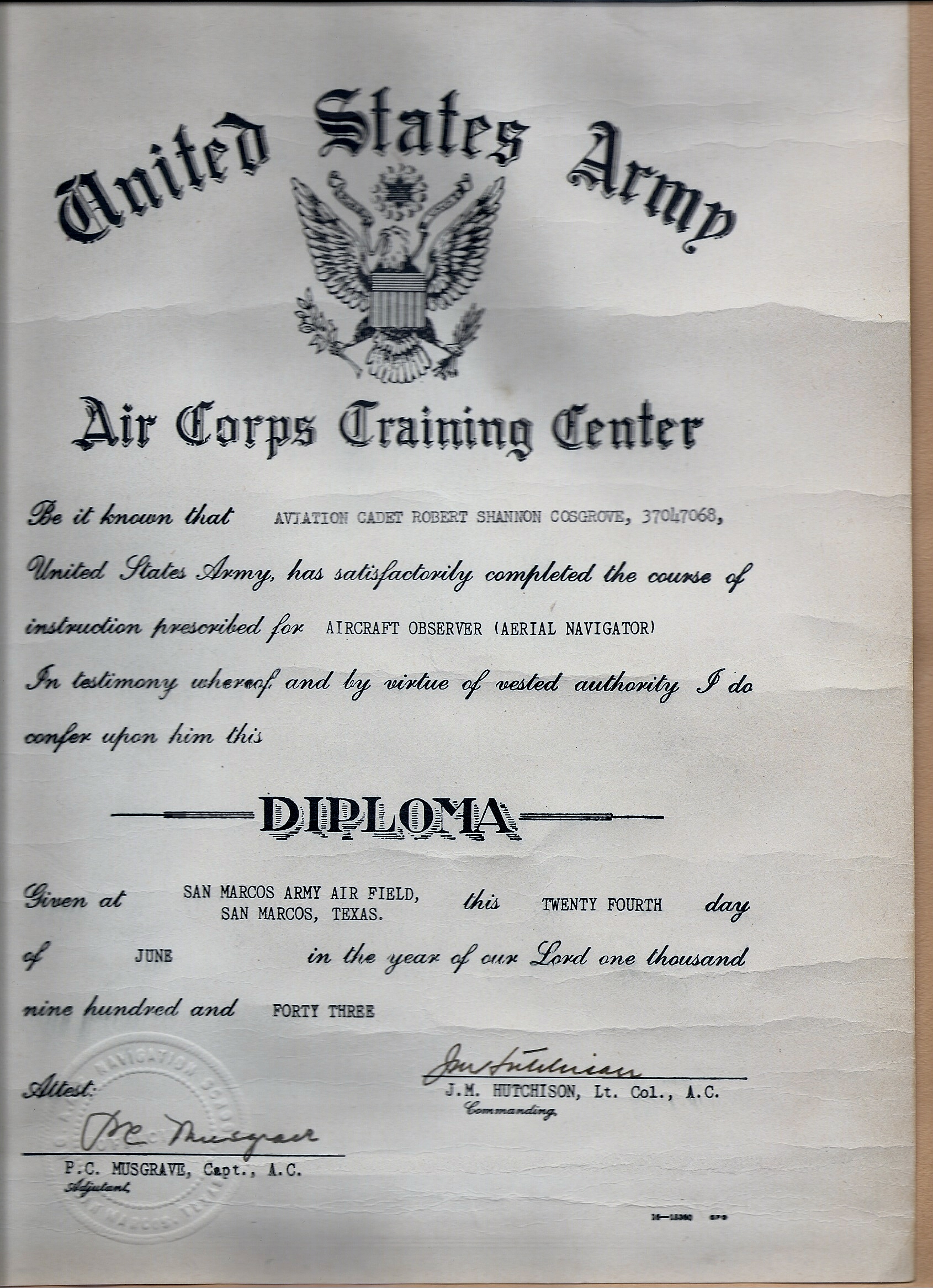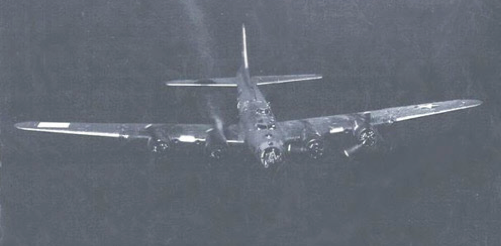Encyclopedia Dubuque
"Encyclopedia Dubuque is the online authority for all things Dubuque, written by the people who know the city best.”
Marshall Cohen—researcher and producer, CNN
Affiliated with the Local History Network of the State Historical Society of Iowa, and the Iowa Museum Association.
COSGROVE, Robert S.: Difference between revisions
(Created page with "200px|thumb|left|Image courtesy: Tracey DavisCOSGROVE, Robert S. (Dubuque, IA--Geefsweer, Holland, Sept. 27, 1943). Robert S. Cosgrove was inducted to...") |
No edit summary |
||
| Line 1: | Line 1: | ||
[[File:armydiploma. | [[File:armydiploma.jpg|200px|thumb|left|Image courtesy: Tracey Davis]]COSGROVE, Robert S. (Dubuque, IA--Geefsweer, Holland, Sept. 27, 1943). Robert S. Cosgrove was inducted to the United States Army Air Corps in Dubuque on July 16, 1941. At this time, he was listed as an electrician. He attended the training center at San Marcos Army Air Field in San Marcos, Texas and received his diploma as an aircaft observer (aerial navigator) on June 24, 1943. | ||
On September 6, 1943 the bomber "Connecticut Yankee" was over Stuttgart, Germany on her 38th mission over the continent. 2Lt William G. Pegram and his crew were flying their second mission in Connecticut Yankee, as No. 3 of the Lead Element of the Low Squadron. The aircraft took flak damage over the target, knocking out an inboard engine. Gas consumption was high in the remaining engines, causing two to run dry while over the English Channel. Connecticut Yankee made landfall on one good engine, but was losing altitude. The final engine cut out as its tank emptied. Since there was still enough altitude to do so, Lt Pegram ordered the crew to bail out. | On September 6, 1943 the bomber "Connecticut Yankee" was over Stuttgart, Germany on her 38th mission over the continent. 2Lt William G. Pegram and his crew were flying their second mission in Connecticut Yankee, as No. 3 of the Lead Element of the Low Squadron. The aircraft took flak damage over the target, knocking out an inboard engine. Gas consumption was high in the remaining engines, causing two to run dry while over the English Channel. Connecticut Yankee made landfall on one good engine, but was losing altitude. The final engine cut out as its tank emptied. Since there was still enough altitude to do so, Lt Pegram ordered the crew to bail out. | ||
Revision as of 04:18, 16 January 2014
COSGROVE, Robert S. (Dubuque, IA--Geefsweer, Holland, Sept. 27, 1943). Robert S. Cosgrove was inducted to the United States Army Air Corps in Dubuque on July 16, 1941. At this time, he was listed as an electrician. He attended the training center at San Marcos Army Air Field in San Marcos, Texas and received his diploma as an aircaft observer (aerial navigator) on June 24, 1943.
On September 6, 1943 the bomber "Connecticut Yankee" was over Stuttgart, Germany on her 38th mission over the continent. 2Lt William G. Pegram and his crew were flying their second mission in Connecticut Yankee, as No. 3 of the Lead Element of the Low Squadron. The aircraft took flak damage over the target, knocking out an inboard engine. Gas consumption was high in the remaining engines, causing two to run dry while over the English Channel. Connecticut Yankee made landfall on one good engine, but was losing altitude. The final engine cut out as its tank emptied. Since there was still enough altitude to do so, Lt Pegram ordered the crew to bail out.
The chute of the navigator, 2Lt Robert S. Cosgrove, would not open when he pulled his rip cord. He had to tear off the canvas cover as he fell through the air to get the canopy released. The chute of the left waist gunner, Sgt Frederick E. Hutchinson, opened inside the fuselage as he jumped, leaving him dangling outside the plane. The ball turret gunner, S/Sgt Hans W. Wobst, gathered up the chute and pushed it out, saving Sgt Hutchinson's life. The rest of the crew, except for Lt Pegram, bailed out safely.
Lt Pegram put Connecticut Yankee down in a wheels-up dead-stick belly landing in a swamp near Winchelsea. Although the muddy swamp acted as grease, allowing a smooth landing, she was badly damaged structurally. Because of the combined damage from flak and the rough landing, Connecticut Yankee was declared salvage and did not fly again.
Originally assigned to the 335th BS in May 1943, this aircraft was later transferred to the 324th BS 91st BG based at Bassingbourn. It was renamed “Local Girl.” Among the crew was Robert S. Cosgrove.
On September 17, 1943 "Local Girl" was part of a mission involving three hundred heavy bombers. The mission was the first operational use of radar-guided bombing on a German target. Emden, Holland was chosen because of its coastal position which would be more clearly defined on the radar scopes in the event of overcast.
Shortly after bombs away, German Me109s struck the formation and set Local Girl's No.2 engine ablaze. The ball turret gunner had left his position as a result of oxygen problems, and the German fighters were quick to exploit that blind spot. Striking from below, they poured 20mm shells into the radio room and splinters smashed the intercom. The pilot, 2Lt William Pegram, was on his fourth mission in Local Girl and held the ship as steady as he could while the crew bailed out - it was to cost him his life. Other hits tore through the fuel tanks and ignited fuel which burned through the spars until the wing broke away, cartwheeling the rest of the aircraft through the sky with gunner Sgt Melvin Peters blazing away until the last moment.
Eight of the crew clawed their way out of the doomed plane and one by one their chutes popped open, but three of them descended into water. Two men became entangled in a network of fishing fences constructed from twigs and branches and in their heavy clothing they had little chance of survival. The bombardier, Norman Eatinger, was more fortunate and was pulled from the water by a fisherman. The wreckage of "Local Girl" plunged to earth at Geefsweer, south of Delfzijl. The bodies of Lt Pegram and S gt Peters were found close by. A loyal Dutchman who reached the scene of the crashed plane before the Germans arrived and smashed its instruments to prevent them falling into the enemy's hands. Relics of "Local Girl" were held by the Dutch, including one of her propeller assemblies.
LOCAL GIRL 42-3111 B-17F-25-DL 91/324-AI DF-A Crew LOCAL GIRL 42-3111 MIA 27 September 1943 (P) 2Lt William G Pegram (Kia) (CP) William L Martin (Pow) (N) 2Lt Robert S Cosgrove (Kia) (B) 2Lt Norman C Eatinger (Pow) (TT) T/Sgt Vernon C Larsen (Kia) (RO) T/Sgt OrIo G Natvig (Pow) (BTG) Paul R Ayala (Pow) (WG) S/Sgt Frederick Hutchinson (Pow) (WG) Sgt Melvin J Peters (Kia) (TG) Gordon E Noel (Pow)



